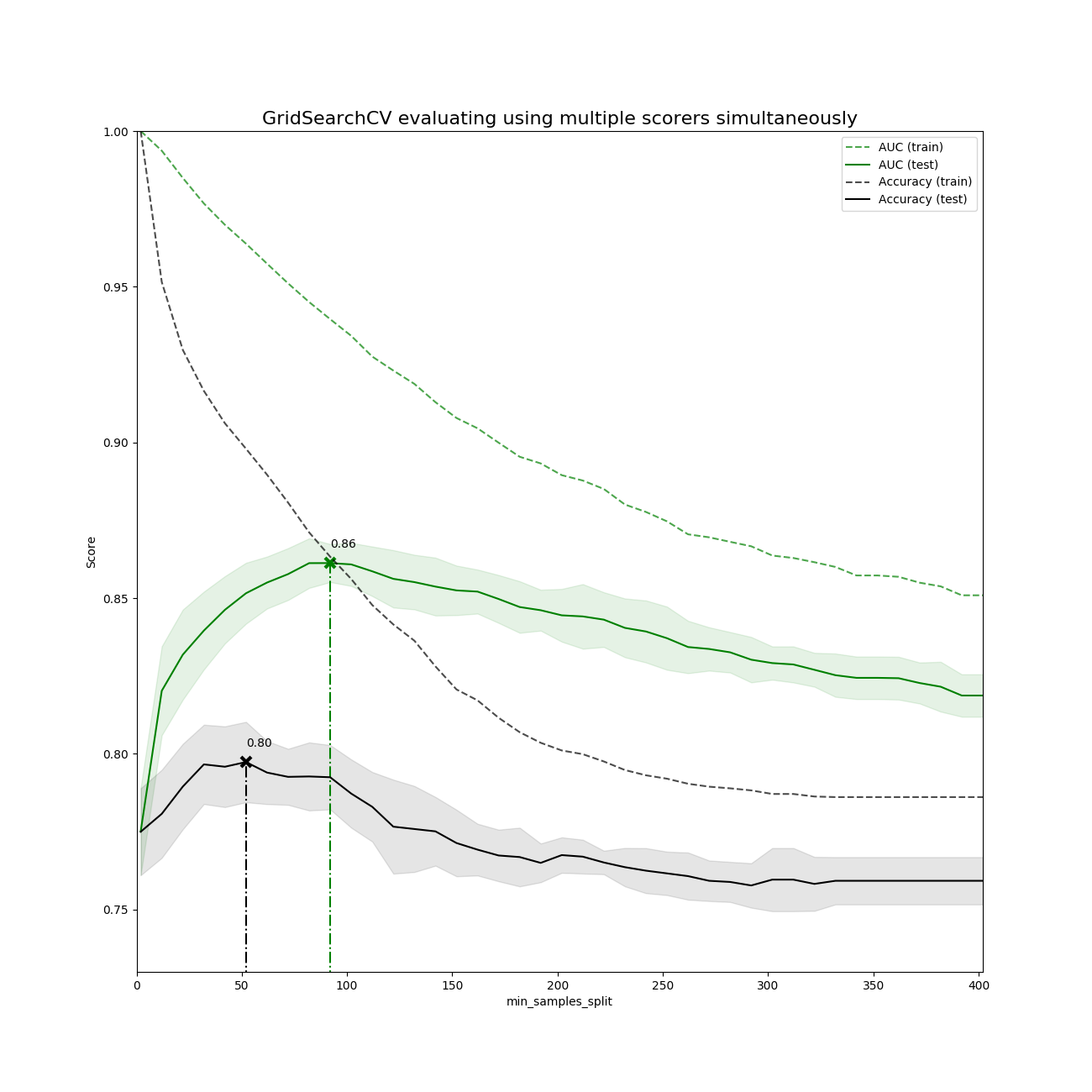Note
Click here to download the full example code or run this example in your browser via Binder
Demonstration of multi-metric evaluation on cross_val_score and GridSearchCV¶
Multiple metric parameter search can be done by setting the scoring
parameter to a list of metric scorer names or a dict mapping the scorer names
to the scorer callables.
The scores of all the scorers are available in the cv_results_ dict at keys
ending in '_<scorer_name>' ('mean_test_precision',
'rank_test_precision', etc…)
The best_estimator_, best_index_, best_score_ and best_params_
correspond to the scorer (key) that is set to the refit attribute.
# Author: Raghav RV <rvraghav93@gmail.com>
# License: BSD
import numpy as np
from matplotlib import pyplot as plt
from sklearn.datasets import make_hastie_10_2
from sklearn.model_selection import GridSearchCV
from sklearn.metrics import make_scorer
from sklearn.metrics import accuracy_score
from sklearn.tree import DecisionTreeClassifier
print(__doc__)
Running GridSearchCV using multiple evaluation metrics¶
X, y = make_hastie_10_2(n_samples=8000, random_state=42)
# The scorers can be either be one of the predefined metric strings or a scorer
# callable, like the one returned by make_scorer
scoring = {'AUC': 'roc_auc', 'Accuracy': make_scorer(accuracy_score)}
# Setting refit='AUC', refits an estimator on the whole dataset with the
# parameter setting that has the best cross-validated AUC score.
# That estimator is made available at ``gs.best_estimator_`` along with
# parameters like ``gs.best_score_``, ``gs.best_params_`` and
# ``gs.best_index_``
gs = GridSearchCV(DecisionTreeClassifier(random_state=42),
param_grid={'min_samples_split': range(2, 403, 10)},
scoring=scoring, refit='AUC', return_train_score=True)
gs.fit(X, y)
results = gs.cv_results_
Plotting the result¶
plt.figure(figsize=(13, 13))
plt.title("GridSearchCV evaluating using multiple scorers simultaneously",
fontsize=16)
plt.xlabel("min_samples_split")
plt.ylabel("Score")
ax = plt.gca()
ax.set_xlim(0, 402)
ax.set_ylim(0.73, 1)
# Get the regular numpy array from the MaskedArray
X_axis = np.array(results['param_min_samples_split'].data, dtype=float)
for scorer, color in zip(sorted(scoring), ['g', 'k']):
for sample, style in (('train', '--'), ('test', '-')):
sample_score_mean = results['mean_%s_%s' % (sample, scorer)]
sample_score_std = results['std_%s_%s' % (sample, scorer)]
ax.fill_between(X_axis, sample_score_mean - sample_score_std,
sample_score_mean + sample_score_std,
alpha=0.1 if sample == 'test' else 0, color=color)
ax.plot(X_axis, sample_score_mean, style, color=color,
alpha=1 if sample == 'test' else 0.7,
label="%s (%s)" % (scorer, sample))
best_index = np.nonzero(results['rank_test_%s' % scorer] == 1)[0][0]
best_score = results['mean_test_%s' % scorer][best_index]
# Plot a dotted vertical line at the best score for that scorer marked by x
ax.plot([X_axis[best_index], ] * 2, [0, best_score],
linestyle='-.', color=color, marker='x', markeredgewidth=3, ms=8)
# Annotate the best score for that scorer
ax.annotate("%0.2f" % best_score,
(X_axis[best_index], best_score + 0.005))
plt.legend(loc="best")
plt.grid(False)
plt.show()

Total running time of the script: ( 0 minutes 21.081 seconds)
